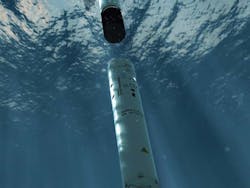Navy orders anti-submarine warfare (ASW) sonobuoys with sensor-fusion capability in $222.3 million deal
PATUXENT RIVER NAS, Md. – U.S. Navy anti-submarine warfare (ASW) experts are replenishing their supplies of advanced multistatic air-launched sub-hunting sonobuoys that work together with other sonobuoys to detect, pinpoint, and track enemy submarines.
Officials of the Naval Air Systems Command at Patuxent River Naval Air Station, Md., announced a $222.3 million contract last week to ERAPSCO in Columbia City, Ind., and to the Lockheed Martin Corp. Rotary and Mission Systems segment in Manassas, Va., to build as many as 18,000 AN/SSQ-125 multistatic sonobuoys for airborne ASW operations.
Sonobuoys are air launched expendable, electro-mechanical ASW acoustic sensors designed to relay underwater sounds of ships and submarines. Sonobuoys enable Navy ASW forces to track potentially hostile submarines operating in the open ocean and in coastal areas that could be threats to Navy carrier battle groups or other forces. Information from these systems can help enable precision attacks with air-launched torpedoes.
ERAPSCO and Lockheed Martin will compete for orders of the AN/SSQ-125 sonobuoys under terms of this contract. Navy fixed-wing aircraft and helicopters can drop a pattern of sonobuoys, which relay information back to the aircraft by radio link, to determine the exact locations of enemy submarines.
The AN/SSQ-125 sonobuoys work together with the Navy's AN/SSQ series of sonobuoys, which consist of the SSQ-36 bathythermograph (BT); SSQ-53 passive directional low frequency analyze and record (DIFAR); SSQ-62 directional command active sonobuoy system (DICASS); SSQ-101 air deployed active receiver (ADAR); SSQ-110 multi-static non-coherent source; and SSQ-125 multi-static coherent source.
The AN/SSQ-125 sonobuoy is a source in a multistatic field, and can generate a variety of waveforms, and is designed to work with the AN/SSQ-53F, AN/SSQ-77C, and AN/SSQ-101 (ADAR) sonobuoys.
A multistatic sonar system contains several spatially diverse monostatic or bistatic sonar components with a shared area of coverage, and enable Navy ASW operators to use sensor fusion to combine the power of the separate sonobuoys.The AN/SSQ-125’s RF channel can be programmed to any of the standard sonobuoy operating channels. At any time after deployment, the AN/SSQ-125 can be commanded to change its operating parameters or depth (deeper only), generate a ping, or scuttle.
The AN/SSQ-125 sonobuoy is a source in a multistatic field, and can generate a variety of waveforms, and is designed to work with the AN/SSQ-53F, AN/SSQ-77C, and AN/SSQ-101 (ADAR) sonobuoys.
The AN/SSQ-125’s RF channel can be programmed to any of the standard sonobuoy operating channels. At any time after deployment, the AN/SSQ-125 can be commanded to change its operating parameters or depth (deeper only), generate a ping, or scuttle.
The AN/SSQ-36B provides vertical temperature profiles of the ocean layer for ASW and research, and used widely in ASW operations to evaluate local effects of seawater temperature on sonar propagation and acoustic range prediction.
The AN/SSQ-53F uses four hydrophones -- each one a multichannel directional piezoelectric ceramic transducer -- that operate at depths of 90, 200, 400, and 1,000 feet to listen for potentially hostile submerged enemy submarines. Aircraft can drop a pattern of sonobuoys, which relay information back to the aircraft by radio link, to determine the exact locations of enemy submarines.
Related: Navy boosting C4ISR, multi-sensor intelligence capabilities of P-8A Poseidon ASW aircraft
The SSQ-53F has three sensors: a constant shallow omni (CSO), an advanced DIFAR sensor, and a calibrated wideband omni. The buoy digitally conditions and amplifies the acoustics and provides directional data that helps establish azimuthal bearing to the submarines being tracked.
The AN/SSQ-62E DICASS sonobuoy is for detecting and localizing submarines in preparation for attack. I can provide range and bearing to the target to fix position, and can support any of the four acoustic frequencies as selected via the Electronic Function Select.
The AN/SSQ-101 ADAR sonobuoy provides a commandable passive search capability, and functions as the receiver in a multistatic active receiver system. The device uses a pentagon-shaped horizontally oriented pattern of hydrophones to detect and beam form underwater sound waves.
Related: Lockheed Martin to provide Navy with advanced towed-array sonar for surface warships
ERAPSCO operates as a joint venture between the Sparton Corp. Defense & Security segment in Le Leon Springs, Fla., and Ultra Electronics USSI in Columbia City, Ind.
On this contract ERAPSCO and Lockheed Martin will do the work in De Leon Springs and Clearwater, Fla.; Columbia City, Ind.; and Manassas, Va., and should be finished by March 2024.
For more information contact ERAPSCO online at http://erapsco.com, or Naval Air Systems Command at www.navair.navy.mil.
About the Author
John Keller
Editor-in-Chief
John Keller is the Editor-in-Chief, Military & Aerospace Electronics Magazine--provides extensive coverage and analysis of enabling electronics and optoelectronic technologies in military, space and commercial aviation applications. John has been a member of the Military & Aerospace Electronics staff since 1989 and chief editor since 1995.
